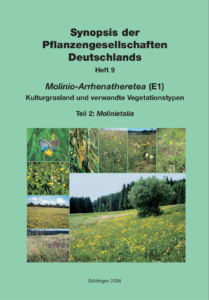 In 1985, a “Working Group for plant sociology”, which was primarily intended to promote cooperation between relevant German experts, was founded within the “Floristisch-soziologische Arbeitsgemeinschaft”. Within the framework of the group, conferences and excursions were organised. Part of the remit of the working group was the task of compiling a vegetation overview of the Federal Republic of Germany on the basis of the detailed evaluation of original data (vegetation surveys). Following initial suggestions from the initial working group, various smaller groups were formed to concentrate on individual vegetation classes or their subunits. The results were to be published in a separate publication series called „Synopsis of the plant communities of Germany“.
In 1985, a “Working Group for plant sociology”, which was primarily intended to promote cooperation between relevant German experts, was founded within the “Floristisch-soziologische Arbeitsgemeinschaft”. Within the framework of the group, conferences and excursions were organised. Part of the remit of the working group was the task of compiling a vegetation overview of the Federal Republic of Germany on the basis of the detailed evaluation of original data (vegetation surveys). Following initial suggestions from the initial working group, various smaller groups were formed to concentrate on individual vegetation classes or their subunits. The results were to be published in a separate publication series called „Synopsis of the plant communities of Germany“.
In 1990, the expert group was transferred to the “Reinhold-Tüxen-Gesellschaft (RGT)” as the „Arbeitskreis für Syntaxonomie“ under the leadership of Hartmut Dierschke. Further meetings took place during the RGT’s annual conferences. From 1996 onwards, the first Synopsis booklets appeared (see below). However, the initial enthusiasm for the work gradually waned, especially as many younger members showed less interest in syntaxonomic questions. Some groups for individual syntaxa progressed slowly due to lack of time caused by other projects of their members, others stopped or never started their work. Finally, due to a lack of participation, the working group was dissolved at the 2019 RTG annual meeting.
Nevertheless, the Synopsis series was quite successful. Between 1996 and 2023, 14 issues and one special issue were published in loose succession and met with great interest. Six issues deal with large groups of forest and shrub communities, four booklets deal with different grassland communities and one each is dedicated to dwarf rush communities and the vegetation of springs, salt marshes and related communities as well as arable weed communities (see below).
For each plant community (from association upwards) syntaxonomy and nomenclature, extent and floristic delimitation, structure, species association and division are dealt with. This is followed by shorter sections on ecological conditions, dynamics, distribution, economic importance, biocenology and nature conservation. At the core of these works are plant sociological overview tables based on an extensive number of vegetation surveys from all over Germany, plus a comprehensive bibliography.
At present, activities in the area are reduced and the publication of further issues is questionable.
Synopsis issues
Synopsis of the plant communities of Germany
Edited for the „Floristisch-soziologische Arbeitsgemeinschaft“ and the „Reinhold-Tüxen-Gesellschaft“ by Hartmut Dierschke (issues 1 to 12) and Werner Härdtle (issues 13 und 14, Göttingen. ISSN 1433-8440
The PDF files of the published issues of the „Synopsis der Pflanzengesellschaften Deutschlands“ are available for download here.
- Hölzel, N. (1996): Erico-Pinetea (Alpisch-Dinarische Karbonat-Kiefernwälder). (49 p.) (printed edition available) [PDF 7,2 MB]
- Härdtle, W., Heinken, T., Pallas, J. & Welß, W. (1997): Quercion roboris (Bodensaure Eichenmischwälder). (51 p.) (out of print) [PDF 6,3 MB]
- Dierschke, H. (1997): Arrhenatheretalia (Wiesen und Weiden frischer Standorte). (74 p.) (out of print) [PDF 8,7 MB]
- Weber, H. E. (1998): Franguletea (Faulbaum-Gebüsche). (86 p.) (out of print) [PDF 9,9 MB]
- Weber, H. E. (1999): Rhamno-Prunetea (Schlehen- und Traubenholunder-Gebüsche) (108 p.)(printed edition available) [PDF 9,0 MB]
- Weber, H. E. (1999): Salicetea arenariae (Dünenweiden-Gebüsche). (37 p.) (printed edition available) [PDF 5,4 MB]
- Täuber, T. & Petersen, J. (2000): Isoëto-Nanojuncetea (Zwergbinsen-Gesellschaften). (87 p.) (printed edition available) [PDF 8,2 MB]
- Peppler-Lisbach, C. & Petersen, J. (2001): Nardetalia strictae (Borstgrasrasen). (117 p.) (out of print) [PDF 13,0 MB]
- Burkart, M., Dierschke, H., Hölzel, N. Nowak, B. & Fartmann, T. (2004): Molinietalia und Klassenübersicht Molinio-Arrhenatheretea (Futter- und Streuwiesen feucht-nasser Standorte und Übersicht Kulturgrasland). (103 p. + Beilage) (out of print) [PDF 12,0 MB]
- Heinken, T. (2008): Dicrano-Pinion (Sand- und Silikat-Kiefernwälder). (88 p.) (printed edition available) [PDF 12,8 MB]
- Dierschke, H. (2012): Polygono-Potentilletalia anserinae (Kriech- und Flutrasen). (104 p. + Beilage) (printed edition available) [PDF 11,6 MB]
- Hinterlang, D. (2017): Montio-Cardaminetea (Quell- und Waldsumpf-Gesellschaften). (110 p.) (printed edition available) [PDF 12,3 MB]
- Hobohm, C., Dierssen, K. & Härdtle, W. (2022): Salzwiesen und verwandte Gesellschaften. (100 p.) (printed edition available) [PDF 6,3 MB]
- Hilbig, W. & Nezadal, W. (2023): Stellarietea mediae – Vogelmieren-Ackerunkrautgesellschaften. (192 p. + Beilage) (printed edition available) [PDF 5,1 MB]
Printed editions
For members of the „Floristisch-soziologische Arbeitsgemeinschaft“, the purchase of the Synopsis issues are included in the membership fee. Members of the „Reinhold-Tüxen-Gesellschaft“ can obtain the issues at a reduced price from the office of the „Floristisch-soziologische Arbeitsgemeinschaft“. Other interested people can ask the office for the prices of the respective printed editions (depending on year of publication and volume).
Special issues
- Weber, H. E. (2001): Internationaler Code der Pflanzensoziologischen Nomenklatur (ICPN). Deutsche Version der 3. Auflage. (61 p.) (printed edition available) [PDF 7,1 MB]
